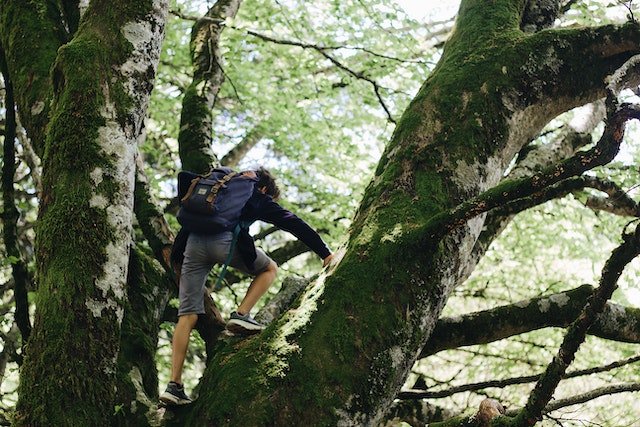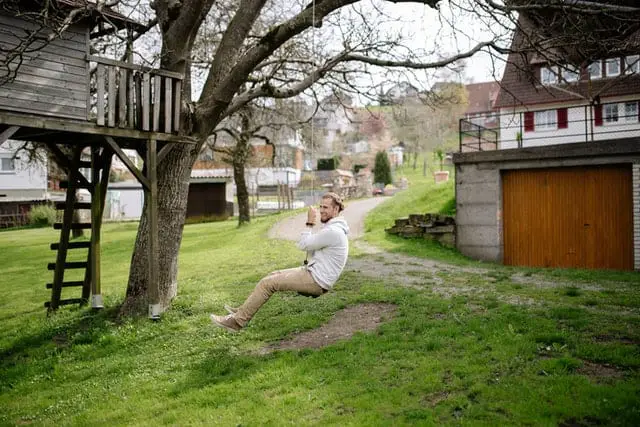Knowing how to hang a tree swing on an angled branch ensures your yard is safe and attractive. Tree swings adds an entertaining and exciting look to your backyard, turning them into a kid-friendly haven.
It becomes more challenging to attach a swing when dealing with an angled branch, but it is still achievable if you calculate the difference between the high and low end of the branch.
Follow along as we look at safely constructing a tree swing on an inclined limb and learn the best practices on how to hang a tree swing on an angled branch.
Tree swings are a great addition to any home for children, as well as one of the most delicate items you can put in your yard. You should be able to easily hang a tree swing if you have a sturdy tree.
Most individuals, of course, have trees with branches parallel to the ground, but when it comes to an inclined branch, some safety precautions are must be taken.
How to Hang A Tree Swing On An Angled Branch?

To hang a tree swing on an angled branch:
- Measure the distance between the swing’s higher and lower points.
- Add the leeway to the rope holding the swing’s higher-end while installing it.
- Double-check and adjust the swing to ensure its level before tying it off. If you want to enjoy summer in an old-fashioned way, you’ll need a tree swing, but how you install it matters a lot.
We’ll demonstrate how to operate with an angled branch.
Hanging a swing on a branch involves the methods outlined below.
- Selecting the Best Branch
- Picking the Appropriate Rope
- Hanging A Swing On An Angled Branch
- Problems In Installing an Angled Branch
#1 Selecting the Best Branch
If you pick a thin branch for your swing, it will not be safe. Before you start, make sure the branch you wish to hang your swing from has a diameter of at least eight inches on both sides. Do not attempt to hang a swing on a dead tree or branch, as it is more likely to snap.
When you’ve found a suitable branch, you’re ready to hang a swing. Pick a swing that appeals to you.
#2 Picking the Appropriate Rope

When it comes to installing a swing, rope type does matter. Regular twine won’t work. We recommend using high-quality polyester (or polymer) rope developed for use on swings. Use it only if it is designed to support human weight.
A manila rope with a diameter of at least 3/4 inches is the most popular rope for a tree swing. This typically carries a weight load of 695 pounds and has that traditional rope look that everyone adores. Polyester is preferable if you wish to carry a heavier load. Polyester ropes have a breaking strength of nearly 1,400 pounds!
#3 Hanging A Swing On An Angled Branch
Now you’ve found a suitable swing branch, it’s time to hang the swing. We’ve included the safest method for hanging a standard swing in these instructions.
- Add four inches to the width of your swing. Make a note of it for future reference. Determine the place where you want the swing to be installed on your branch.
- At two spots, drill a vertical hole into the tree. The distance between the points should be the same as what you just estimated.
- Take a level and bring it up to the branch. Climb a ladder if necessary. Hold the level parallel to the lowest hole, then angle it to entirely even. Calculate the distance between the top of the level and the upper branch. Remember or write down that measurement. This is the value you’ll use to calculate your offset.
- Cut a 1-inch PVC pipe into a long section. The pipe should be an inch longer than the branch’s diameter plus the offset. For instance, a 13-inch pipe should have an eight-inch diameter and a four-inch offset.
- Drill across the top of the pipe, 1/2 inch down, with a 3/8-inch bit. Purchase a long nut and bolt set that fits and fastens to those measurements.
- Drill out the higher portion of the tree branch with a 1-inch bit. Using a 1-inch bit, drill out the upper half of the tree branch. Push the pipe up through the top of the hole. The perforations in the pipe should be towards the top rather than the bottom. Secure the pipe to the branch with the long nut and bolt kit, with the offset dipping beneath the branch. This will help to balance out the swing.
- Feed one of the two ropes through the tube and tie a large knot there. You should secure the nut and bolt across the top of the tube’s distance. It will aid in controlling your ropes.
- On the tree’s opposite side, cut and tie a long rope. This will be located on the tree’s lower side.
- Place your swing at the bottoms of both ropes and tie a knot. Use a level to even out the knots to ensure that your swing set is safe and level.
#4 Problems In Installing an Angled Branch

An angled branch will not give you an exact length, and if put incorrectly, the swing would bend in an arc rather than straight.
Assume that the angle branch is the only one accessible, or you choose to use it for personal reasons. In that situation, it is recommended to extend the swing slightly to avoid an unintentional collision.
Another issue with adopting an angled arc is that it may slip off. Even after fastening the swing by tying a rope around the limb, there’s a chance it’ll wiggle its way to the bottom. In that case, wrap the additional rope around the rope in invisible mode.
Also read: How To Clear Land of Small Trees and Brush
Conclusion
A swing in your yard is a great way to entertain children; t may survive for years if correctly installed. This entails long-term entertaining activities for the whole family. That’s still another reason you should learn how to connect a swing to a tree branch, particularly angle branches.
Following the above methods will help you acquire a straight branch swing despite the slant if you have a tree swing with no horizontal branch but only an inclined branch. Keep in mind that your child should not be allowed to swing unattended.
Frequently Asked Questions
Is It Safe To Swing On A Tree?
Even before amusement parks, tree swings were a popular garden feature. They’ve been thought to be safe for millennia, but that safety is conditional. To be considered safe, a swing must be appropriately placed, be mounted on a safe branch, and be made of high-quality rope.
Most tree swings on the market are very safe to use. If you’re unsure, examine the rope more closely. If the rope appears frayed or worn, you should take precautions and avoid swinging on that specific swing.
How Much Does A Professional Installation Of A Tree Swing Cost?
Getting expert installers can be difficult due to the effort and supplies required to install a tree swing. If you locate them, the professionals expect to pay between $350 and $1000 for tree swing installation. This includes all parts, installation, and tree preparation.
When Should A Traditional Tree Swing’s Rope Be Replaced?
Believe it or not, Ropes on trees don’t survive as long as you think they do. To maintain optimal safety against the elements and damage, we recommend replacing the rope on a tree swing every two to three years. While many families do not do this, it is always better to be cautious in any situation.
Video link- Watch out the video for more knowledge.

Hey, I’m Lisa and I’ve been an avid gardener for over 30 years. I love writing, talking and living in the garden! Feel free to connect with me on my socials below

